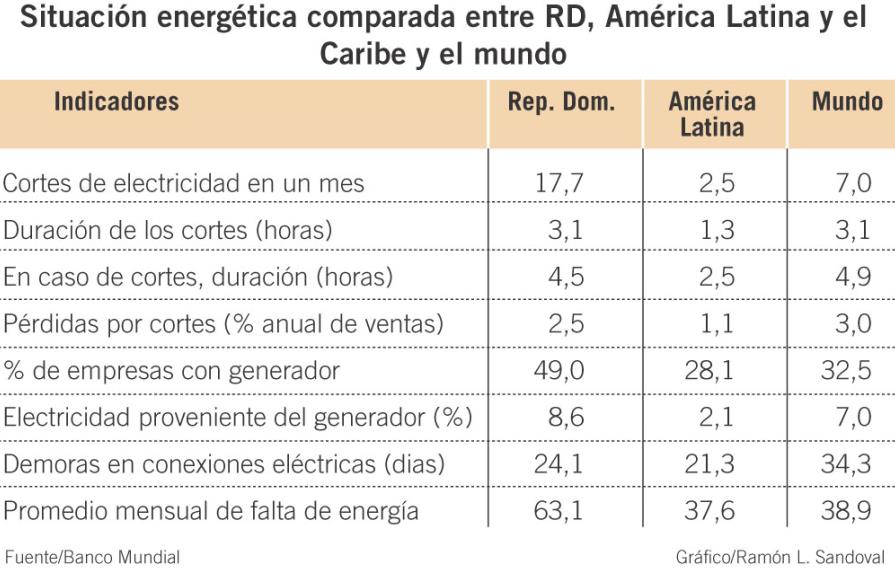DR, the country in Latin America and Caribbean with most blackouts

SD. Of the 31 countries in Latin America and the Caribbean-not including Haiti-the Dominican Republic is the nation with the highest number of registered electricity blackouts. When a typical month in the region shows an average of 2.5 electricity blackouts and in the world, seven, in this country there have been 17.7.
The next territory on the list is Guyana, but it is far from the Dominican average since it registers an average of 8.4 blackouts a month.
This is how a report from the World Bank compares things. The field work was a survey of 360 local companies between March and September 2011, which reported on a list of 15 obstacles for doing business in the Dominican Republic and the electricity problem is number one. In second place they places the tax environment and in third place corruption.
The information reported by the companies made the report show that when the countries of Latin America and the Caribbean happen to have a cut in the electric energy, the average duration of the suspension of service is 2.5 hours while in the Dominican Republic it is 4.5 hours.
In each country the number of business surveyed was different.
Economic Impact
Of the 360 business surveyed, 49% said that they needed a generator as an alternate electricity supply, when the average in Latin America and the Caribbean is 28.1% and at the world level it is 32.5%. Nonetheless, Bahamas, Jamaica, St. Kitts and Nevis, Surinam and Granada have the highest percentages in the region.
Those Dominican businesses, distributed in 122 manufacturers, 117 retail sales and 121 other services, averaged annual losses in sales of 4.4% in the cases of electricity cuts, a percentage higher than the 2.8% for Latin America and the Caribbean but less than the 5% worldwide figure.
The energy problem in the Dominican Republic has been around for decades in spite of the plans to privatize and capitalize carried out by the authorities in 1998. Economic and political interests are also indicated by sectors as obstacles for its improvement.
The debts also envelop the issue. According to the Dominican Association of the Electricity Industry (ADIE), the debt to the generators is US$708,170,899 as of 18 January.
At the end of last year, President Danilo Medina blamed the International Monetary Fund for being the "fundamental entity responsible" for the financial crisis that affects the electricity sector and he criticized the fact that the technicians from this multilateral agency believe that the problem can be solved by increasing the collections, improving the technical losses and reducing the stealing of electricity.
The director of the National Energy Commission, Enrique Ramirez, said that the government is working to improve the system and gave as an example the fact that today they will inaugurate the second stage of the Los Cocos Wind Farm which, with the installation of 26 additional wind turbines will generate 52 megawatts that will be added to the 25 megawatts that are produced by the 14 wind turbines in the first stage.
The government also has under consideration the construction of two coal fired generation facilities, with each one producing 300 megawatts, at a cost of US$1.2 billion.
Businessmen demand the signing of the electricity pact
President Danilo Medina assured reporters that the solution to the energy problem comes with the signing of the energy pact.
The businessmen also agree to this, but the optimism of these business men and women becomes skeptical when they calculate that last 26 January was the one year deadline for signing this pact, according to what the National Development Strategy had laid out.
"This pact should be summoned as soon as possible," demanded yesterday Circe Almanzar, the executive vice president of the Industrial Association of the Dominican Republic.
The recipe of the business community is for the government to work on reducing the losses in distribution, in the investments in generation for the year 2016-when the contracts of the Madrid Accords are up-and improve institutionalism.
But before that can happen, Almanzar said that the businessmen are worried about the fact that for the lack investments in the installed generation capacity there will not be enough energy for the non-regulated customers (large industrial consumers) that buy energy directly from the generators and not the distributors, backed by the Electricity Law.
The next territory on the list is Guyana, but it is far from the Dominican average since it registers an average of 8.4 blackouts a month.
This is how a report from the World Bank compares things. The field work was a survey of 360 local companies between March and September 2011, which reported on a list of 15 obstacles for doing business in the Dominican Republic and the electricity problem is number one. In second place they places the tax environment and in third place corruption.
The information reported by the companies made the report show that when the countries of Latin America and the Caribbean happen to have a cut in the electric energy, the average duration of the suspension of service is 2.5 hours while in the Dominican Republic it is 4.5 hours.
In each country the number of business surveyed was different.
Economic Impact
Of the 360 business surveyed, 49% said that they needed a generator as an alternate electricity supply, when the average in Latin America and the Caribbean is 28.1% and at the world level it is 32.5%. Nonetheless, Bahamas, Jamaica, St. Kitts and Nevis, Surinam and Granada have the highest percentages in the region.
Those Dominican businesses, distributed in 122 manufacturers, 117 retail sales and 121 other services, averaged annual losses in sales of 4.4% in the cases of electricity cuts, a percentage higher than the 2.8% for Latin America and the Caribbean but less than the 5% worldwide figure.
The energy problem in the Dominican Republic has been around for decades in spite of the plans to privatize and capitalize carried out by the authorities in 1998. Economic and political interests are also indicated by sectors as obstacles for its improvement.
The debts also envelop the issue. According to the Dominican Association of the Electricity Industry (ADIE), the debt to the generators is US$708,170,899 as of 18 January.
At the end of last year, President Danilo Medina blamed the International Monetary Fund for being the "fundamental entity responsible" for the financial crisis that affects the electricity sector and he criticized the fact that the technicians from this multilateral agency believe that the problem can be solved by increasing the collections, improving the technical losses and reducing the stealing of electricity.
The director of the National Energy Commission, Enrique Ramirez, said that the government is working to improve the system and gave as an example the fact that today they will inaugurate the second stage of the Los Cocos Wind Farm which, with the installation of 26 additional wind turbines will generate 52 megawatts that will be added to the 25 megawatts that are produced by the 14 wind turbines in the first stage.
The government also has under consideration the construction of two coal fired generation facilities, with each one producing 300 megawatts, at a cost of US$1.2 billion.
Businessmen demand the signing of the electricity pact
President Danilo Medina assured reporters that the solution to the energy problem comes with the signing of the energy pact.
The businessmen also agree to this, but the optimism of these business men and women becomes skeptical when they calculate that last 26 January was the one year deadline for signing this pact, according to what the National Development Strategy had laid out.
"This pact should be summoned as soon as possible," demanded yesterday Circe Almanzar, the executive vice president of the Industrial Association of the Dominican Republic.
The recipe of the business community is for the government to work on reducing the losses in distribution, in the investments in generation for the year 2016-when the contracts of the Madrid Accords are up-and improve institutionalism.
But before that can happen, Almanzar said that the businessmen are worried about the fact that for the lack investments in the installed generation capacity there will not be enough energy for the non-regulated customers (large industrial consumers) that buy energy directly from the generators and not the distributors, backed by the Electricity Law.


 Diario Libre
Diario Libre
 Diario Libre
Diario Libre